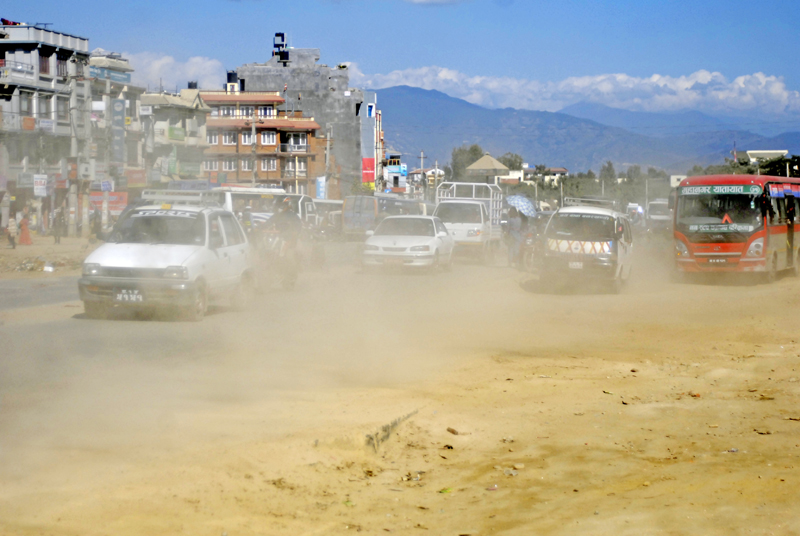Government fails in its responsibility to curb Valley’s dust pollution
Kathmandu, December 31
Even though the constitution guarantees every citizen the right to live in a clean and healthy environment, people have not been able to enjoy the right.
Especially in city areas people are compelled to live with the dust and smoke produced by the ongoing construction works, brick factories, reconstruction of houses destroyed by the earthquakes of last year, the on going road expansion drive of the government and vehicular pollution. These have directly impacted the health of denizens in Kathmandu Valley.
Sunita Shrestha, a local of Anamnagar said that the anti-pollution face mask has become a must for pedestrians. However, she added that the time when we will also have to wear masks inside our houses is not far off.
“Once the road is dug by the drinking water project, then the road construction work starts. After the road is completed then it is again dug up to lay drainage pipes. Then again another department digs the road for some other purpose.
It’s almost like a never ending story that is continually causing dust pollution, thanks to lack of coordination among the government departments.”
Article 30 of the constitution has guaranteed the right to clean environment while clause (1) states that every citizen shall have the right to live in a clean and healthy environment, clause (2) explains that the victim shall have the right to obtain compensation, in accordance with the law for any injury caused from environmental pollution or degradation and clause (3) says that this article shall not be deemed to prevent the making of necessary legal provisions for a proper balance between the environment and development, in development works of the nation.
The government is the responsible body for protecting the rights of citizens by providing healthy environment, but the government itself has been violating the constitution by producing dust and pollution in the environment.
Advocate Padam Shrestha, Coordinator of Environmental law committee and Founder President of Environmental Development and Conservation legal forum said that government was not being responsible towards the constitution of Nepal.
“Construction activities inside the Valley are the main cause of pollution. Construction of houses, roads, pavements, heritage sites, drinking water project and drainage produces dust, which makes it difficult for people to breathe,” he said.
Dust Pollution inside the Valley has been increasing by the day. The maximum limit of PM10 set by the National Ambient Air Quality Standards is 120 micrograms per cubic metre.
According to the report of the Ministry of Science, Technology and Environment Kathmandu air contains 400 micrograms of particulate matter up to 10 micrometres per cubic metre. Likewise, another 2014 report by Clean
Energy Nepal shows that Kathmandu air contains 260 micrograms of particles smaller than 2.5 micro metres in size per cubic metre.
The pollution level has increased from 40 micrograms per cubic meter to 204 micrograms per cubic metre in the Valley after the earthquakes according to the study of LEADERS NEPAL.






